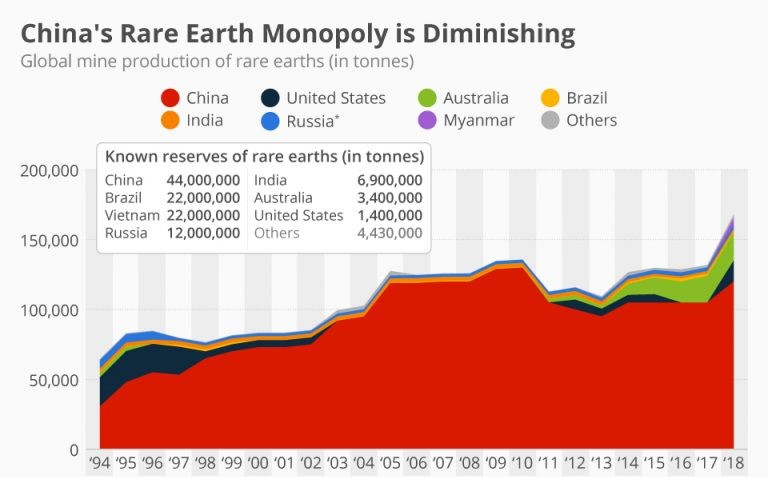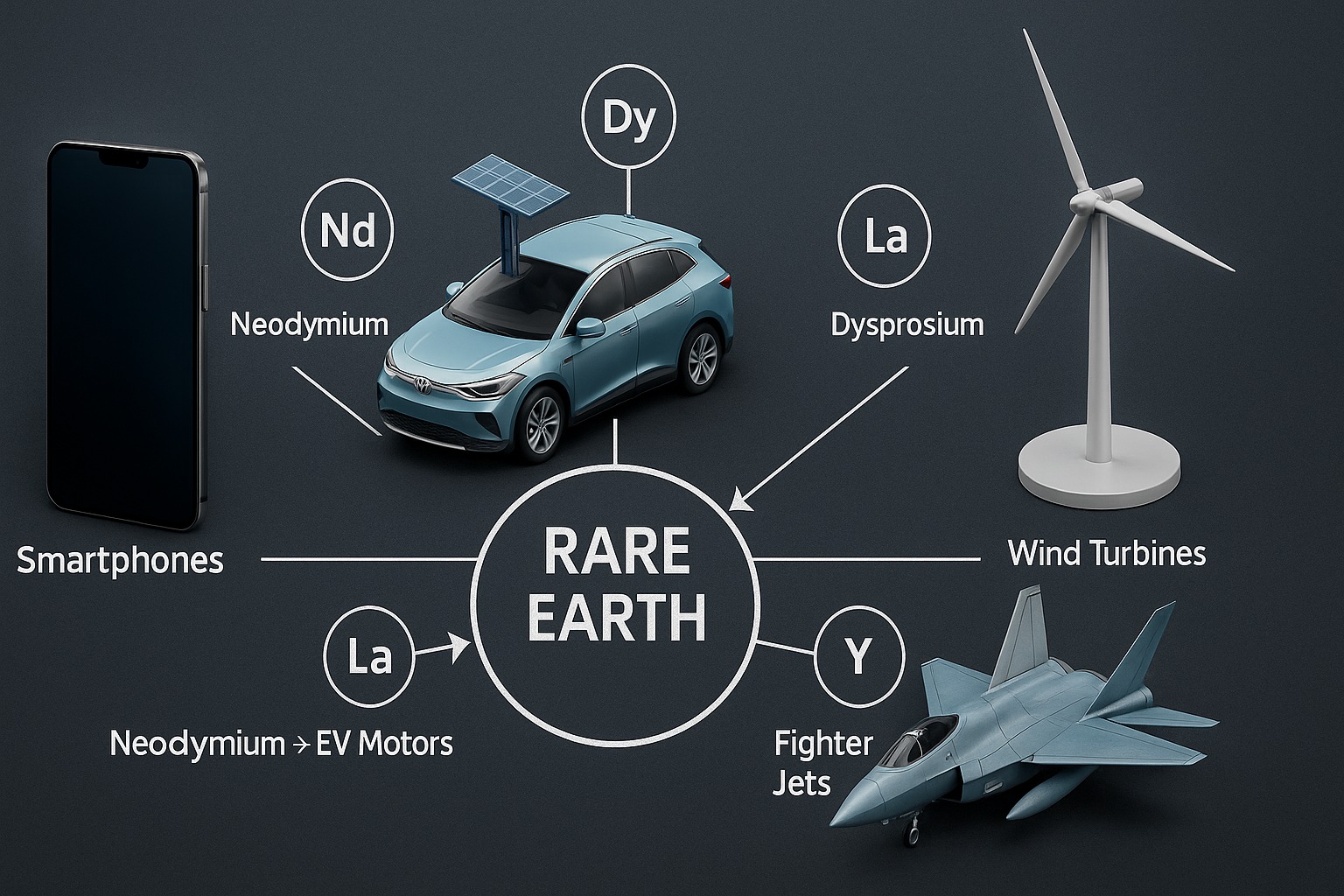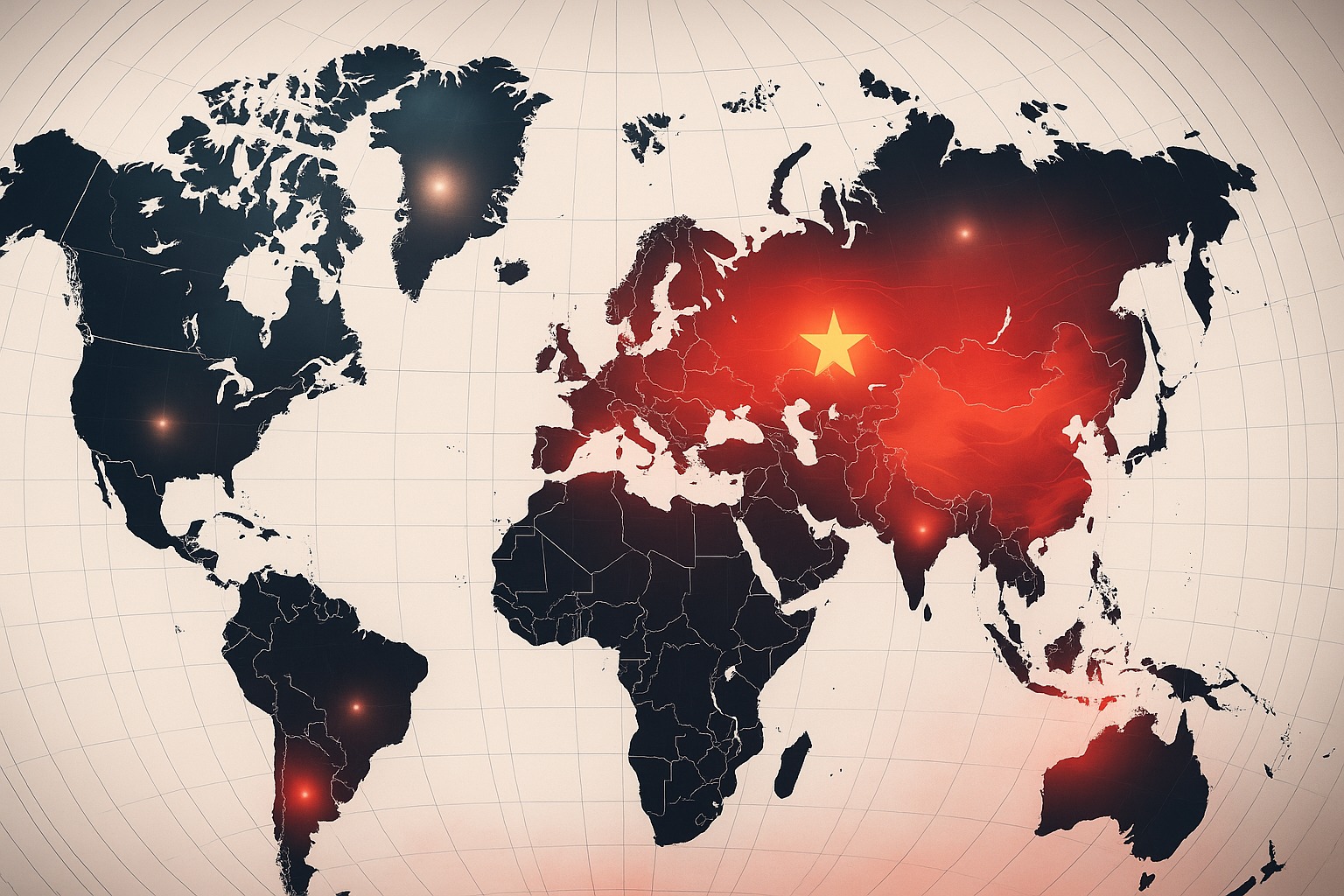Introduction: Rare Earth, Rare Problem
China’s Rare Earth Monopoly: China controls a large portion (60-70%) of global rare earth elements — materials that are crucial for high-tech industries, like electric vehicles, defense systems, semiconductors, and renewable energy.
In 2025, China tightened its grip further by introducing export license requirements on 7 key rare earth elements. Since then, global markets have felt the tremors—especially tech, auto, and defense sectors.
But why does this matter to investors?
Let’s decode.

What Are Rare Earth Metals, and Why Do They Matter So Much?
Rare earth metals may sound exotic, but they’re quietly powering the modern world—from your smartphone to electric cars and even fighter jets. These 17 chemical elements—like Neodymium, Dysprosium, Lanthanum, and Yttrium—are hidden behind the scenes in almost every cutting-edge technology.
1.Not So Rare, But Hard to Extract
Though they’re called “rare,” rare earth elements (REEs) are actually quite abundant in the Earth’s crust. What makes them special—and difficult—is the way they’re scattered in ores, making extraction expensive, complex, and environmentally damaging. This tough production process is what keeps them in short and strategic supply.
2.The Backbone of Modern Technology
Rare earth metals have unique magnetic, optical, and electronic properties that make them irreplaceable in advanced tech. Here’s how:
Neodymium & Dysprosium: Used to make strong permanent magnets essential for electric vehicle (EV) motors, wind turbines, and high-end electronics.
Lanthanum is commonly used in hybrid car batteries and high-quality camera lenses.
Yttrium, Europium & Terbium: Give vibrant colors to LED screens, TVs, and energy-efficient lighting.
3.Fueling the Green Energy Revolution
Rare earth elements form the backbone of the clean energy future.. EVs, wind farms, and solar panels need them to improve performance and reduce emissions. Without rare earths, the global shift toward sustainable energy would slow down dramatically.
4.Critical for National Security Too
It’s not just about gadgets and green power. The defense sector depends heavily on rare earths for:
Missile guidance systems
Jet engines
Satellite and radar technology
This makes rare earths not just economically important, but also a strategic military resource.
5.The China Factor: A Global Weak Spot
Here’s the catch: China dominates the rare earth market, controlling over 70% of global production.. This near-monopoly gives it massive influence over global tech and energy supply chains. Any disruption—from trade wars to export bans—can cause shockwaves in global markets.

What Did China Do Recently?
In April 2025, China enforced strict export controls on the following rare earth elements:
Samarium, Gadolinium, Terbium, Dysprosium, Lutetium, Scandium, and Yttrium
This wasn’t just a trade move—it was a strategic counterattack in the growing U.S.–China tech war. The U.S. had just imposed fresh tariffs on Chinese EVs, batteries, and chips.
This move jolted global supply chains.
How China Became the Rare Earth Superpower
China’s dominance in rare earth metals is no fluke — it’s the result of a long-term, calculated strategy. By leveraging cost advantages, technical expertise, and strategic geopolitics, China has cemented its role as the undisputed leader in the global rare earth supply chain. But why is this dominance so impactful—and what dangers does it present to the rest of the world?
1️⃣ Low-Cost Manufacturing: The Competitive Moat
China has created a cost structure that’s nearly impossible to beat. How?
- Cheap labour
- Government subsidies
- Flexible environmental norms
Together, these factors allow China to produce rare earths at a significantly lower cost than its global competitors. As a result, many Western mining and refining operations have either scaled down or shut shop entirely — unable to compete on cost alone.
Even today, countries trying to restart their rare earth industries face economic challenges that China sidestepped years ago.
2️⃣ The Real Power: Processing, Not Mining
Rare earth metals aren’t truly rare — but turning them into usable form is a technical nightmare. Processing involves high energy, toxic waste, and precision engineering.
China spent decades mastering this part of the chain. Today, it controls nearly 90% of global refining capacity, meaning that even countries that mine rare earths often send their raw materials to China for processing.
In short: China owns the bottleneck — and that’s where the real leverage lies.
3️⃣ Full Supply Chain Control: From Ore to Exports
China isn’t just mining and refining rare earths — it controls the entire value chain:
– Mining
– Refining
– Component manufacturing (like magnets and alloys)
– Export of finished tech-ready materials
This vertical integration ensures that maximum value — and profit — stays within China. It also means other countries depend on China not just for raw materials, but for critical tech components built on top of them.
4️⃣ Export Power = Global Pressure
China has used its rare earth dominance as a geopolitical lever in the past — and it can do it again.
For example, during a diplomatic standoff with Japan in 2010, China briefly cut off rare earth exports, sending global prices soaring and supply chains scrambling.
Through export restrictions, tariffs, and regulatory shifts, China can influence global markets in ways few others can. This isn’t just economic — it’s strategic.
5️⃣ The Green Energy Leverage
Rare earths are the unsung heroes of the renewable revolution. They’re essential in:
Electric vehicle motors
Wind turbines
Solar energy components
As the world chases net-zero goals, demand for these metals is rising fast. And since China holds the cards, it is strategically placed to influence the future of sustainable technology — both economically and diplomatically.
6️⃣ Geopolitical Leverage: Strategic Material = Strategic Power
Rare earths are also military-critical. They’re used in:
Missile guidance systems
Radar and satellite tech
Jet engine components
By controlling access to these materials, China indirectly holds sway over defense ecosystems across the globe. This makes rare earths not just an economic resource, but a national security issue for many countries.
7️⃣ The Global Risk: Overdependence on One Nation
While China’s position strengthens its global influence, it leaves the rest of the world exposed. Any disruption — whether due to a political clash, trade war, or even a natural disaster — could ripple through:
Electronics manufacturing
Auto supply chains
Defense readiness
Green energy transitions
That’s why countries like the U.S., Canada, Australia, and India are now racing to build alternative supply chains and domestic processing capabilities.

How China’s Rare Earth Dominance Impacts the World
China’s firm grip on the rare earth metals market doesn’t just give it an economic edge — it creates ripple effects across tech innovation, climate action, and national security worldwide. As these elements form the backbone of modern technology and renewable energy, China’s control over the supply chain presents both strategic leverage and systemic risk for the rest of the world.
1. Tech Titans Under Pressure
From smartphones to electric cars, the world’s most valuable companies depend on rare earths:
– Apple relies on these metals for speakers, vibration units, and camera components in iPhones.
– Tesla uses neodymium-based magnets in EV motors for enhanced efficiency.
– Samsung integrates rare earths in LED displays and semiconductors
Since China dominates both the mining and refining of these elements, even a minor supply chain disruption — whether due to trade policy, diplomatic tension, or export restrictions — could:
– Push up material costs
– Delay production cycles
– Create long-term instability in supply chains
This makes global tech firms highly exposed to decisions made in Beijing.
2. Clean Energy’s Hidden Dependency
The green energy revolution isn’t possible without rare earth metals. These elements power the hardware behind climate goals:
– Wind turbines depend on permanent magnets made from neodymium and dysprosium.
– Electric vehicles use rare earths like lanthanum and cerium in motors and batteries.
– Solar power systems rely on components requiring precise magnetic and conductive properties.
While countries ramp up their climate commitments, they’re still heavily reliant on China to source these critical materials. This creates a paradox — the race to net-zero could be delayed or derailed by a geopolitical supply squeeze.
3. National Security in the Crosshairs
Rare earth metals aren’t just powering gadgets and green tech — they’re also mission-critical for military capabilities:
– Jet engines
– Missile guidance systems
– Advanced surveillance and radar technologies
The United States, for example, still imports most of its rare earth needs from China, despite ongoing efforts to reduce dependency. In a geopolitical standoff or armed conflict, China’s control over these materials could give it a strategic upper hand, compromising a nation’s defense preparedness.
This dependency has prompted urgent action across the West to secure alternative supply chains — from funding new mining projects to investing in domestic refining technology.
Five Indian Sectors Under Threat
India imports over 90% of its rare earth elements, mostly from China.
Electric Vehicles (EVs): High-magnet prices impacting Ola, Tata, Mahindra
Defense: Hindustan Aeronautics, BHEL, DRDO reliant on imported components
Renewable Energy: Suzlon and ReNew Power face delays in turbine production
Electronics: Dixon, Lava, and contract manufacturers struggle with magnet imports
Heavy Machinery: Bharat Forge, L&T, Cummins see margin compression
Conclusion: Rare Earths, Real Consequences
This isn’t just a supply chain story. We’re in a new world where commodities aren’t just about oil and gold. Strategic materials like rare earths are shaping the battlefield of tech, defense, and energy. And China sits at the top.
For investors, the message is clear:
Expect volatility in downstream sectors (EVs, tech, defense)
Watch for long-term opportunity in REE miners and processors
Pay attention to policy more than price
As nations rush to secure their technological future, rare earths are no longer hidden elements. They are power.
And power is moving.
FAQ for Readers
Q: Which Indian stocks are exposed to rare earths?
Tata Motors, Exide, Vedanta (potential beneficiary), Hindustan Aeronautics, BHEL (indirectly)
Q: What are some global REE-related stocks?
MP Materials, Lynas Corp, Energy Fuels Inc.
Q: Can India become self-reliant?
Yes, with government support, tech partnerships, and policy reforms. But it will take time—5–10 years.
